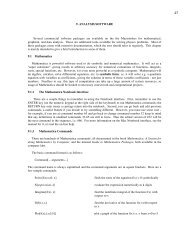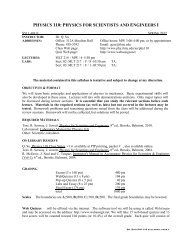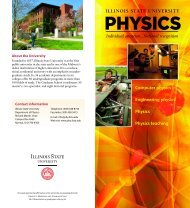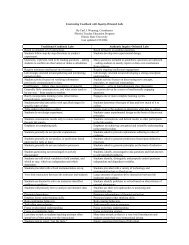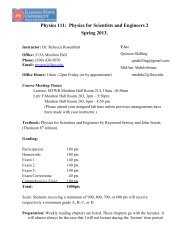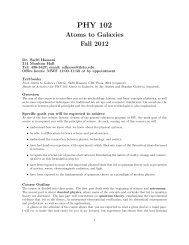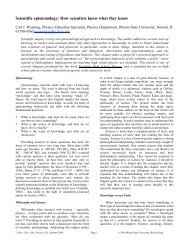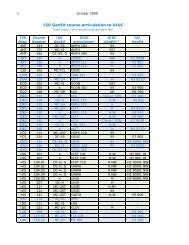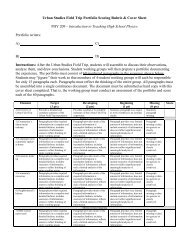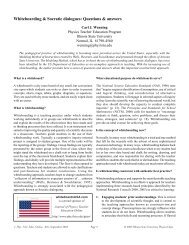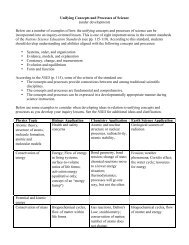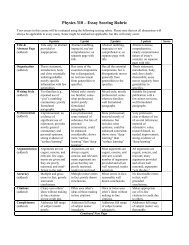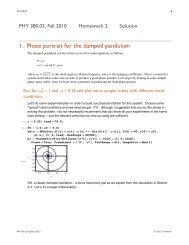The Creative Genius of Isaac Newton - Illinois State University
The Creative Genius of Isaac Newton - Illinois State University
The Creative Genius of Isaac Newton - Illinois State University
Create successful ePaper yourself
Turn your PDF publications into a flip-book with our unique Google optimized e-Paper software.
<strong>The</strong> <strong>Creative</strong> <strong>Genius</strong> <strong>of</strong> <strong>Isaac</strong> <strong>Newton</strong><br />
(<strong>The</strong> Simple Case)<br />
by Carl J. Wenning, Coordinator<br />
Physics Teacher Education Program<br />
<strong>Illinois</strong> <strong>State</strong> <strong>University</strong><br />
<strong>The</strong>re are several geniuses in the field <strong>of</strong> Renaissance astronomy and physics known to almost every<br />
educated person – Copernicus, Galileo, Kepler, and <strong>Newton</strong> among them. What was the creative genius <strong>of</strong><br />
these individuals? While it would take an encyclopedic book to be able to answer that question, the<br />
current paper is much more modest. It is the purpose <strong>of</strong> this paper to explain in very few words the<br />
creative genius <strong>of</strong> <strong>Isaac</strong> <strong>Newton</strong> in relation to his formulation <strong>of</strong> the theory <strong>of</strong> gravitation. (It is called here<br />
a theory rather than a law because <strong>of</strong> the empirical evidence that has been built up over the years in<br />
verification <strong>of</strong> the hypothetical form <strong>of</strong> the mathematical formulation that was not derived from<br />
experiment – e.g., a law.)<br />
<strong>The</strong> story <strong>of</strong> <strong>Newton</strong> sitting under an apple tree one day seeing an apple fall and thinking about the form<br />
<strong>of</strong> gravitation is probably apocryphal. Nonetheless, it could have occurred to <strong>Newton</strong> that the fall <strong>of</strong> an<br />
apple is not unlike that <strong>of</strong> the fall <strong>of</strong> the Moon as it orbits the Earth. It was the fact that he was able to<br />
understanding the relationship between the Moon and the apple that constitutes the real creative genius <strong>of</strong><br />
<strong>Isaac</strong> <strong>Newton</strong>. Couched in modern SI terms, this is what <strong>Newton</strong> did….<br />
He realized that the acceleration <strong>of</strong>, say, an apple near the surface <strong>of</strong> the Earth was 9.8 m/s 2 (in modern<br />
terms). That is,<br />
a "<br />
= 9.8 m s 2<br />
He then calculated the centripetal acceleration <strong>of</strong> the Moon in its orbit around the Earth by using an<br />
equation first provided by the Dutch scientists <strong>of</strong> his day:<br />
! a "<br />
= v 2<br />
r<br />
<strong>The</strong> speed <strong>of</strong> the Moon’s motion was easily derived from the relationship into which he put the proper<br />
values for the orbital radius <strong>of</strong> the Moon and its sidereal period (both known with a high degree <strong>of</strong><br />
precision in his day)<br />
!<br />
v = d t = circumference = 2"r<br />
period P = 2"(384,000,000m) =1020m / s<br />
2,360,000s<br />
Using the equation for centripetal acceleration, he then came up with the value <strong>of</strong> the Moon’s acceleration<br />
(1020m / s)2<br />
a " = = 0.00271m / s2<br />
!<br />
384,000,000m<br />
He then compared the acceleration <strong>of</strong> objects near the Earth’s surface with that <strong>of</strong> the Moon in orbit and<br />
found<br />
!<br />
a " 9.8m / s 2<br />
=<br />
= 3600 = 602<br />
2<br />
a # 0.00271m / s<br />
In this case, 60 represented the radius <strong>of</strong> the Moon’s orbit in Earth radii. From this comparison, <strong>Newton</strong><br />
was able to conclude that the acceleration <strong>of</strong> the Moon in its orbit was inversely proportional to its<br />
distance from the center <strong>of</strong> the<br />
!<br />
Earth squared. That is,<br />
a "<br />
# 1 2<br />
r "<br />
!
Given the fact that F=ma, <strong>Newton</strong> concluded that the force required to hold the Moon in its orbit around<br />
the Earth (and any planet in orbit around the Sun) was similarly dependent upon distance squared. That is,<br />
F " 1 r 2<br />
Because gravity is responsible for the perceived weight <strong>of</strong> objects, and is proportional to the mass <strong>of</strong> the<br />
object, m, (and supposedly the mass <strong>of</strong> the gravitating body, M), <strong>Newton</strong> was able to hypothesize that,<br />
! F " Mm<br />
r 2<br />
Inserting the proportionality constant, G, gives us the familiar form <strong>of</strong> <strong>Newton</strong>’s formulation.<br />
F = GMm<br />
r 2<br />
So, it should be evident from this deduction<br />
!<br />
that <strong>Newton</strong>’s act <strong>of</strong> creative genius was in the fact that he<br />
was able to use observational evidence to formulate a hypothetical relationship for the nature <strong>of</strong> the<br />
central gravitational force required to keep objects in orbital motion. Now, how could this hypothesis be<br />
!<br />
tested? A generation earlier, Johannes Kepler formulated three planetary laws <strong>of</strong> motion based upon<br />
observation <strong>of</strong> the planet Mars. He stated these laws thusly:<br />
1. Planets move in elliptical orbits around the Sun with the Sun located at one <strong>of</strong> the foci.<br />
2. <strong>The</strong> radius arm between a planet and the Sun sweeps out equal areas in equal time intervals.<br />
3. <strong>The</strong> period <strong>of</strong> a planet expressed in years squared equals the semi-major axis (mean radius) <strong>of</strong> the<br />
orbit expressed in astronomical units cubed. That is,<br />
P 2 = r 3<br />
If the units are arbitrary (e.g., SI units), then the form <strong>of</strong> the equation would be<br />
P 2 = kr 3<br />
where the value and units <strong>of</strong> k would depend upon the units employed in the equation’s other variables. At<br />
this point <strong>Newton</strong>, with his new formulation ! <strong>of</strong> gravity and his own second law, was able to write<br />
! F = ma = mv 2<br />
= GMm<br />
r r 2<br />
Substituting for v ( 2"r P ) and canceling, <strong>Newton</strong> arrived at the following relationship using the two<br />
rightmost components <strong>of</strong> this equation. That is,<br />
! P 2 = 4" 2 r 3<br />
!<br />
GM = kr 3<br />
which is Kepler’s third or harmonic law! <strong>Newton</strong>’s formulation <strong>of</strong> the law <strong>of</strong> gravity therefore was able to<br />
explain why the harmonic law was <strong>of</strong> the nature derived by Kepler – it’s because gravity has an inversesquared<br />
nature. Hypothesis then, with this firm underpinning, was on its way to becoming theory.<br />
!<br />
Note that this formulation is for the simple case that assumes purely circular motion. In reality, the solar<br />
system’s moons and planets move with elliptical and barycentric motion. Taking both <strong>of</strong> these<br />
considerations into account, <strong>Newton</strong> was able to derive a more precise form <strong>of</strong> the Harmonic law<br />
(M + m)P 2 = 4" 2 r 3<br />
G<br />
where M and m are the masses <strong>of</strong> the bodies in, say, SI units. If M and m are expressed in solar mass units,<br />
P in years, and r in astronomical units, then the equation simplifies to<br />
(M + m)P 2 = r 3<br />
This relationship was used to measure<br />
!<br />
the masses <strong>of</strong> various solar system bodies in solar mass units<br />
centuries before the space age. Fly-bys <strong>of</strong> moons and planets with interplanetary spacecraft have verified<br />
this relationship, and provide additional evidence that <strong>Newton</strong>’s formulation <strong>of</strong> gravity is correct.<br />
Additionally, sending spacecraft on ! interplanetary missions using <strong>Newton</strong>’s formulation <strong>of</strong> gravity as a<br />
guide has proven to be extremely accurate, showing once again that <strong>Newton</strong> was correct in his
hypothetical assertion <strong>of</strong> the nature <strong>of</strong> gravity. <strong>The</strong> hypothetical form <strong>of</strong> the law <strong>of</strong> gravitation has become<br />
well-substantiated theory due to the vast amount <strong>of</strong> empirical evidence that supports it.<br />
It should be noted, too, that <strong>Newton</strong>’s more detailed analysis <strong>of</strong> the central force problem resulted in a<br />
prediction <strong>of</strong> elliptical motion – precisely what Kepler observed. That is, when gravitational force is<br />
assumed to drop <strong>of</strong>f with in inverse-square <strong>of</strong> the distance, then elliptical motion results. This formulation<br />
is beyond the scope <strong>of</strong> this book. Kepler’s law <strong>of</strong> equal areas is also readily explained by <strong>Newton</strong>’s<br />
formulation <strong>of</strong> gravity.



